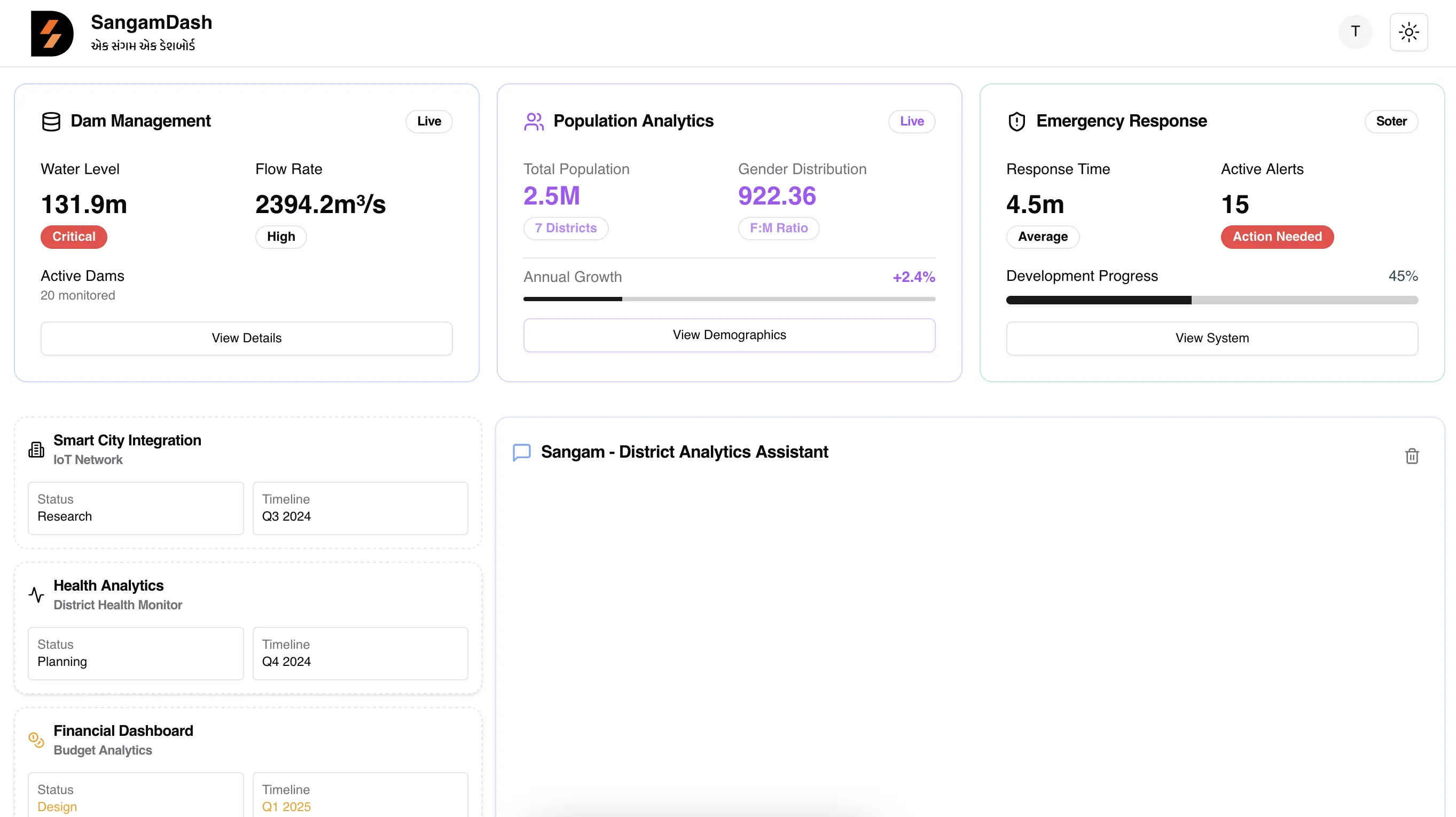SangamDash
SangamDash is a centralized district-level integrated dashboard developed for the Government of Mahesana. It consolidates project data from multiple departments, enabling better decision-making, improved transparency, and faster response times across the administration.
Overview
SangamDash was created to address the challenge of monitoring numerous government projects scattered across departments. By centralizing all critical project data in one interactive dashboard, officials can track progress, identify bottlenecks, and collaborate more effectively — resulting in a 25% improvement in governance efficiency.

SangamDash dashboard interface showcasing real-time project monitoring across departments
Key Features
📊 Centralized Project Monitoring
- Unified View: Real-time tracking of 20+ projects from 10 departments.
- Progress Indicators: Visual KPIs, completion percentages, and milestones.
- Data Filters: Department-wise, priority-wise, or project-phase filtering.
- Cross-Department Insights: Identify dependencies and collaborative opportunities.
🔍 Transparency & Accountability
- Public-Facing View: Optional transparency layer for public awareness.
- Audit Trails: Track changes and updates to project data.
- Performance Reports: Generate periodic reports with visual charts.
- Data Integrity Checks: Automated validation of submitted data.
⚡ Real-Time Data Integration
- API-Based Updates: Secure APIs to fetch data from departmental databases.
- WebSocket Integration: Instant updates without page reloads.
- Offline Mode: Cached last-known data for reliability in low-connectivity areas.
- Scalable Backend: PostgreSQL database optimized for large datasets.
🛡️ Role-Based Access Control (RBAC)
- Admin Panel: For system administrators to manage users and permissions.
- Departmental Access: Restricted views for specific departments.
- Secure Authentication: Multi-factor authentication for sensitive data.
- Granular Permissions: View-only vs edit permissions.
Technical Architecture
Frontend Development
Built with React.js and Next.js, SangamDash provides:
- Server-Side Rendering: Faster initial load and better SEO.
- TypeScript: Strong typing for maintainable and error-free code.
- Responsive Design: Works on desktops, tablets, and mobile devices.
- Component Reusability: Modular architecture for scalability.
Programming Language
TypeScript ensures:
- Strong Type Safety: Reduces runtime errors.
- Maintainable Codebase: Easier to scale and refactor.
- IDE Autocomplete: Developer productivity boosts.
- Clear Interfaces: Better API contracts between frontend and backend.
Data Management
PostgreSQL powers the backend:
- Relational Data Storage: Ideal for structured government data.
- High Performance: Optimized queries for large datasets.
- Data Security: Role-based access at the database level.
- Scalability: Ready for expansion to more departments or districts.
User Experience Design
Intuitive Interface
- Clean Layout: Prioritizes clarity for non-technical government staff.
- Interactive Charts: Quickly grasp project statuses.
- Accessibility: Meets WCAG standards.
- Consistent UI: Aligns with government branding.
Personalization
- Custom Dashboards: Each department can have its own view.
- Saved Filters: Quickly access commonly used views.
- Notification Preferences: Choose which updates to receive.
- Language Support: Local language interface for ease of use.
Technical Challenges and Solutions
Challenge: Multi-Department Data Integration
Problem: Inconsistent formats and update cycles.
Solution: Implemented a standardized API layer with ETL (Extract, Transform, Load) processes.
Challenge: Real-Time Performance
Problem: Delays in reflecting updated project statuses.
Solution: Added WebSocket support for push-based updates.
Challenge: Security & Privacy
Problem: Handling sensitive government data.
Solution: Encrypted data at rest and in transit, with strict RBAC enforcement.
Data Sources and APIs
- Departmental APIs: Real-time project status feeds.
- Manual Data Upload: For departments without APIs.
- External APIs: Integration with budget allocation and GIS mapping systems.
Future Roadmap
Phase 1: Analytics Expansion
- Predictive Analytics: Forecast project delays and budget overruns.
- Automated Alerts: Notify stakeholders of critical changes.
- Advanced Filtering: Multi-dimensional project analysis.
Phase 2: Inter-District Collaboration
- State-Level Rollout: Extend to other districts in Gujarat.
- Benchmarking Tools: Compare department performance.
- Mobile App Version: For on-the-go access.
Phase 3: Public Engagement
- Citizen Feedback Module: Allow public to comment on projects.
- Transparency Portal: Publish high-level summaries for citizens.
- Interactive Maps: GIS-based project visualization.
Impact and Metrics
Since implementation:
- 25% Improvement in governance efficiency.
- 20+ Projects tracked in real-time.
- 10 Departments connected on a single platform.
- 100% Data Consistency across departments.
Development Process
Agile Methodology
- Sprint Cycles: Two-week sprints with demo days.
- Stakeholder Meetings: Weekly sync with department heads.
- Continuous Integration: Automated testing and deployments via Vercel.
- Version Control: GitHub-based development workflow.
Quality Assurance
- Unit Testing: For all core features.
- Integration Testing: Department-level API checks.
- Security Audits: Regular penetration testing.
- Load Testing: Ensured performance under peak usage.
Technologies and Tools
Development Stack
- Frontend: React.js, Next.js, TypeScript
- Backend: PostgreSQL
- Hosting: Vercel
- State Management: React Query
- Authentication: JWT with RBAC
Development Tools
- IDE: Visual Studio Code
- Version Control: Git, GitHub
- CI/CD: GitHub Actions
- Design: Figma
- Testing: Jest, Playwright
Conclusion
SangamDash has transformed project monitoring and governance in the Mahesana district by providing a unified, real-time view of all departmental activities. With its scalable architecture, secure data handling, and user-friendly interface, it has set the foundation for a potential state-wide deployment.
Through this project, I gained deep experience in React.js, Next.js, TypeScript, PostgreSQL, and large-scale dashboard design, along with valuable insights into government workflows and high-security application development.